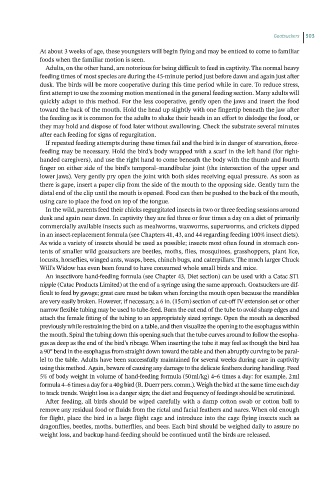Page 506 - Hand rearing birds second
P. 506
Goatsuckers 503
At about 3 weeks of age, these youngsters will begin flying and may be enticed to come to familiar
foods when the familiar motion is seen.
Adults, on the other hand, are notorious for being difficult to feed in captivity. The normal heavy
feeding times of most species are during the 45‐minute period just before dawn and again just after
dusk. The birds will be more cooperative during this time period while in care. To reduce stress,
first attempt to use the zooming motion mentioned in the general feeding section. Many adults will
quickly adapt to this method. For the less cooperative, gently open the jaws and insert the food
toward the back of the mouth. Hold the head up slightly with one fingertip beneath the jaw after
the feeding as it is common for the adults to shake their heads in an effort to dislodge the food, or
they may hold and dispose of food later without swallowing. Check the substrate several minutes
after each feeding for signs of regurgitation.
If repeated feeding attempts during these times fail and the bird is in danger of starvation, force‐
feeding may be necessary. Hold the bird’s body wrapped with a scarf in the left hand (for right‐
handed caregivers), and use the right hand to come beneath the body with the thumb and fourth
finger on either side of the bird’s temporal–mandibular joint (the intersection of the upper and
lower jaws). Very gently pry open the joint with both sides receiving equal pressure. As soon as
there is gape, insert a paper clip from the side of the mouth to the opposing side. Gently turn the
distal end of the clip until the mouth is opened. Food can then be pushed to the back of the mouth,
using care to place the food on top of the tongue.
In the wild, parents feed their chicks regurgitated insects in two or three feeding sessions around
dusk and again near dawn. In captivity they are fed three or four times a day on a diet of primarily
commercially available insects such as mealworms, waxworms, superworms, and crickets dipped
in an insect‐replacement formula (see Chapters 41, 43, and 44 regarding feeding 100% insect diets).
As wide a variety of insects should be used as possible; insects most often found in stomach con-
tents of smaller wild goatsuckers are beetles, moths, flies, mosquitoes, grasshoppers, plant lice,
locusts, horseflies, winged ants, wasps, bees, chinch bugs, and caterpillars. The much larger Chuck
Will’s Widow has even been found to have consumed whole small birds and mice.
An insectivore hand‐feeding formula (see Chapter 43, Diet section) can be used with a Catac ST1
nipple (Catac Products Limited) at the end of a syringe using the same approach. Goatsuckers are dif-
ficult to feed by gavage; great care must be taken when forcing the mouth open because the mandibles
are very easily broken. However, if necessary, a 6 in. (15 cm) section of cut‐off IV extension set or other
narrow flexible tubing may be used to tube‐feed. Burn the cut end of the tube to avoid sharp edges and
attach the female fitting of the tubing to an appropriately sized syringe. Open the mouth as described
previously while restraining the bird on a table, and then visualize the opening to the esophagus within
the mouth. Spiral the tubing down this opening such that the tube curves around to follow the esopha-
gus as deep as the end of the bird’s ribcage. When inserting the tube it may feel as though the bird has
a 90° bend in the esophagus from straight down toward the table and then abruptly curving to be paral-
lel to the table. Adults have been successfully maintained for several weeks during care in captivity
using this method. Again, beware of causing any damage to the delicate feathers during handling. Feed
5% of body weight in volume of hand‐feeding formula (50 ml/kg) 4–6 times a day: for example, 2 ml
formula 4–6 times a day for a 40 g bird (R. Duerr pers. comm.). Weigh the bird at the same time each day
to track trends. Weight loss is a danger sign; the diet and frequency of feedings should be scrutinized.
After feeding, all birds should be wiped carefully with a damp cotton swab or cotton ball to
remove any residual food or fluids from the rictal and facial feathers and nares. When old enough
for flight, place the bird in a large flight cage and introduce into the cage flying insects such as
dragonflies, beetles, moths, butterflies, and bees. Each bird should be weighed daily to assure no
weight loss, and backup hand‐feeding should be continued until the birds are released.

